How Good (or Bad) is a $100 Laptop? The Coda Spirit Review
by Dr. Ian Cutress on March 9, 2020 8:00 AM EST- Posted in
- Laptops
- Intel
- Atom
- IPS
- eMMC
- Notebooks
- Apollo Lake
- 1920x1080
- N3350
- Coda Spirit

Back in late 2014, I remember Brett reviewing the HP Stream 11-inch laptop for $200. At the time, it was a great little machine, offering all you need to do basic workflow and get online with a dual-core Atom and a low-resolution display. Fast forward to 2019, and I picked up a 1080p IPS 13-inch clamshell laptop, with Win 10 Home and storage expansion, for just $100. On paper, this thing is epic for the price. But is it actually worth it?
*This review has been updated relating to its audio since it was first published due to an error.
The Coda Spirit: A Cheap Chinese Atom
A few things have changed since Brett's review. Higher-resolution panels are much cheaper, the whole design concept of clamshell devices has evolved, and the companies in the laptop ecosystem that provide components are now able to offer 4th and 5th generation versions of their controllers for peanuts, while the latest devices play a few generations on. As a result, we have a large number of '3rd tier' companies pushing out cheap systems.
Most of these systems are built down to a price for sure. And truth be told, the Coda Spirit I'm testing today wasn't the absolute cheapest device offered. There was a staggered offering with all the systems offering the same design, same ports, same expandability, except for stuff that can't be changed:
| Stream 11 vs Coda Lineup | |||||
| AnandTech | HP Stream 11 |
Coda Zest |
Coda Spark |
Coda Spirit |
Coda Wave |
| Type | Clamshell | Tablet 2-in-1 | Clamshell | Clamshell | 180-hinge |
| Size | 11.6-inch | 10.1-inch | 11.6-inch | 13.3-inch | 11.6-inch |
| Display | 1366x768 TN |
1200x800 IPS |
1920x1080 IPS |
1920x1080 IPS |
1920x1080 IPS |
| CPU | Celeron N2840 |
Celeron N3350 |
Celeron N3350 |
Celeron N3350 |
Celeron N3350 |
| Memory | 2 GB DDR3L 1333 1-Channel |
2 GB LPDDR4 1600 2-Channel |
2 GB LPDDR4 1600 1-Channel |
4 GB LPDDR4 1600 1-Channel |
4 GB LPDDR4 1600 2-Channel |
| Internal Storage |
32 GB eMMC |
32 GB eMMC 5.1 |
32 GB eMMC 5.0 |
32 GB eMMC 5.0 |
32 GB eMMC 5.1 |
| Optional Storage |
- | - | M.2 2280 > 1 TB |
M.2 2280 > 1 TB |
M.2 2242 > 512 GB |
| microSD | > 64 GB | > 128 GB | > 128 GB | > 128 GB | > 128 GB |
| Wi-Fi | 802.11n Realtek 8223BE |
802.11ac Intel 3125AC |
802.11n Realtek 8273BU |
802.11ac Intel 3125AC |
802.11ac Intel 3125AC |
| Battery | 37 Wh | ? | ? | 38 Wh | ? |
| Weight | 1.23 kg | 0.61 kg | 0.98 kg | 1.22 kg | 0.98 kg |
| Price | $200 (2014) |
$80 on sale $150 MSRP |
$90 on sale $140 MSRP |
$100 on sale $242 MSRP |
$375 as seen $375 MSRP |
$80 for a 10-inch 1200x800 IPS display and 2GB LPDDR3, $90 for an 11-inch 1920x1080 display but still 2 GB memory, and this Spirit we are testing today with a 1080p display but 4 GB memory. I felt the extra $25 was worth it, especially on the memory front, but the whole unit was still $100 in the sale. I posted a teaser on Twitter and it wasn't long before someone asked if it was a cheap Chinese machine with an Atom processor.
For the price, as mentioned, the specifications seem really impressive. At the end of the day, the heart is a dual-core Apollo Lake processor, specifically the N3350, which isn't breaking any performance records any time soon with its 1.1 GHz base frequency and 2.4 GHz turbo. This is paired with 4 GB of LPDDR4-1866 C15, which again isn't bad considering at this price people usually get 2 GB, which to be honest is not enough for Windows 10. Storage is perhaps a weak point, with only 32 GB of eMMC, which means after a full install of Windows 10 Home there is only 18 GB left. But this is one of the party pieces of this design: expandable storage.
Along with the eMMC, there is a microSD card slot. That is in itself a pretty good deal, with 128 GB microSD cards on offer for not much money. But the big add-in is the M.2 slot for storage. This is a proper 2280 sized slot, allowing for any SATA based E-key M.2 drive to be added. For anyone with an extra $100 to spend, there's 1 TB of internal storage ready to go. For those that are adventurous enough to change boot drives, it should help speed up the system no end. For our test, we added in an old 250 GB Samsung 860 EVO SSD, as well as a 128 GB nano-sized USB drive in the single USB-A slot.
The system is also reasonably light for the price. Standard cheap plastic materials here, however they had been finished with an element of finesse on the lid and the keyboard area. The keys have plenty of travel, rather than the chiclet types of keys that I have come to detest as a writer on long trips. The mouse pad has very good detection, and is suitably large for this sort of system, compared to some of the micro-pads used on 15-inch devices.
The power button in the top right corner is actually in the best place for a laptop – I’m forever accidentally putting any laptop with a power button on the side to sleep when I move it (I’m looking at you HP). Unfortunately it doesn’t double as a fingerprint sensor, which would have been gravy, presumably because a fingerprint sensor isn’t suitable at this price point.
Port selection on the Spirit is simple enough: a USB 3.0 Type-A and micro-SD card slot on the top left, and a USB 3.0 Type-C, a micro-HDMI port, and a 3.5mm jack on the bottom left. On the right is the power connector. Unfortunately the power connector here isn’t a Type-C, which would have been great, but the power adaptor is little more than a smartphone charger, rather than a big power brick. The battery is 5000 mAh, which is big for a smartphone, but in laptop-world, that means 38 Wh at 7.6 volts, which for a laptop is actually quite small. In this case having the low powered processor helps, despite the large Full-HD display. The Spirit has a speakers, which are bad, a 3.5mm jack, and the unit also supports BlueTooth headphones.
There was one small hiccup when starting the system. Naturally I wanted to update the unit to Windows 1909, the latest at the time, from the Windows 1809 (17763.168) it shipped with. Unfortunately the onboard eMMC was not enough, saying I needed another 10 GB.
With a USB drive attached, it went further into the process but failed because the point at which it restarts and wants the files from the USB drive, the system doesn’t actually initialize the USB driver stack. It wasn’t until I installed the M.2 SATA SSD that the system took the update.
To find out if other systems will be updated to Windows 1909 out of the box, I went to get in contact with the Coda support team through the website. A big plus is that I got an immediate response to my question: they would have to ask the factory (presumably, Coda is rebadging an ODM design, and they have to ask the ODM). With that in mind, I sent about a dozen technical questions over in the hope I could get those answered as well.
A week later, I got an email, saying that they were still waiting on response. I had not been forgotten!
Another week later, I have another email, with all my answers! Here’s the one relating to Windows 10:
Q: I noticed that the model I purchased came with Windows 10 Home version 1803, which is old. I could update to 1903 fine, but in order to successfully update to 1909, I had to install an M.2 SATA drive. I tried with a microSD card but during the update process the microSD controller is not initialized early enough in order to complete the update. Will future batches be sold with Windows 10 Home 1909 installed?
A: You must have an early device; we update the Windows image with each batch produced. Devices that come preinstalled with 1903 have Reserved Storage enabled (updating to 1903 doesn’t enable this) from what I have seen Reserved Storage fixes all the issue that Windows 10 had when trying to update on low storage devices. Yes, future devices will have a more up to date Windows build.
I also asked other questions about the Coda range:
Q: Can you confirm if all four models use the Intel 802.11 Wireless AC3125?
The WAVE, SPIRIT, ZEST are AC3126 and the SPARK is 8723BU
Q: Do all four models use LPDDR4-1600, or is it LPDDR3X ?
All are LP DDR4
Q: How many memory channels are populated for each model?
The SPARK and SPIRIT are single channel, WAVE and ZEST are dual channel
Q: What version of eMMC is being used?
SPARK and SPIRIT are eMMC 5.0, ZEST and WAVE are eMMC 5.1
Q: Is the M.2 SATA supported through the chipset or is an additional controller used (ASMedia?)
It is direct support.
Q: Does CODA have official peak throughput numbers for the M.2 SATA port?
Basing on our test some SSD the speed is 450MB/S read and write.
Q: Does the company have a steady supply of Apollo Lake N3350 processors? With Intel's recent supply status I am wondering if the company runs specific batches and has committed to a # of CPUs for purchase.
We have no issue with the N3350 supply.
Q: What is the standard warranty length for these devices?
1 year
I must say that for a small unknown Chinese-like Atom device, I didn’t expect such answers to my questions, let alone this level of detail. Having confirmation of some of the onboard controllers on the other systems was good, as well as knowing that the system I have uses single-channel memory whereas two of the others use dual channel.
One key answer that seemed to be very short and quick for them was Atom CPU supply. It looks like they have enough Apollo Lake processors for the foreseeable future.
Under The Hood
With one of these cheap machines, you do expect some sort of cost reduction system in order to turn a profit. Quality of components, simpler items, or perhaps stuff doesn’t work as long (as implied by the one year warranty). But inside I was pleasantly surprised.
The first look inside shows a massive lithium-ion battery. It shows here the 5000 mAh we saw on the box, and the conversion to 38 Wh for laptop land. All the important stuff seems to be on the left-hand side (as seen).
Lifting up the battery, and we see how the system has managed to get it in – it’s just very thin. The design from the packaging makes it out to be a two-cell battery, connected via a single cable.
Here’s the main area of the laptop, with everything in a small PCB. The single metal heatsink is for practically every chip in the system, with zero fan for this design.
Taking the heatsink off, we have a thin copper sheet with a pad for the CPU, and a small raised area for a larger old control chip.
Underneath we have the CPU front and center, with everything onboard. To the left is the Spectek LPDDR4 DRAM, which is rebadged Micron memory, and on the far left is an EtronTech EJ889 which is a USB 3.0 controller. Between the Spectek and the EtronTek is a Realtek ALC269 audio codec. On the right is some Foresee eMMC, with the WiFi chip underneath.
Here is the LPDDR4 chip, showing the Spectek logo and the Micron logo. The datasheet for PS019-075BT gives the information.
The Wi-Fi chip is Intel’s 802.11ac (Wi-Fi 5) 1x1 solution, the AC3165. The module is not upgradeable, but the antennas are well integrated into the system.
This is the Foresee eMMC chip, which Coda told us is eMMC 5.0, however we seem to have an eMMC 5.1 chip.
The fun thing here is that the Foresee spec sheets also give speeds of the chip:
With the NCEMASLD-32G, we should expect to see 200 MB/s read and 110 MB/s write on here. We have some data later in the review.
Finally we have the CPU itself. The Celeron N3350 is a dual-core Atom-based Apollo Lake design, using Goldmont cores on 14nm. The base frequency is 1.1 GHz, with a turbo up to 2.4 GHz, with a TDP of 6 W and SDP of 4 W, which might be akin to a mobile CPU. The graphics inside are HD 500, operating at 200 MHz with a turbo to 650 MHz. Based on a known package size of 31 mm by 24 mm, we can work out that the die size of this chip is 8.92 mm by 10.06 mm, or 89.73 mm2.
The N3350 is actually a 2016 processor, which has been superseded by the Gemini Lake family using Goldmont Plus cores – the N4020 was launched in November 2019 also with two cores, no HyperThreading, but double the L2 cache and +400 MHz on the CPU core, along with HD600 graphics and faster DRAM support. Both are listed by Intel at $107, which would mean that this chip should be more expensive than the entire system (!), but at this point we know that Intel sells laptop CPUs in bulk for far less than the price guides state. I suspect that it was easier for Coda (or Coda’s ODM) to get the N3350 than any of the newer cores given Intel’s recent shortage issues, and the fact that the N3350 was made in 2016 means that there’s plenty of stock in a warehouse somewhere. However, a Goldmont Plus CPU, with its major micro-architectural change, would perhaps have a sizeable performance uplift.
CPU Performance
As with our previous quick reviews, I ran the system through a small number of basic tests to ascertain single-thread performance, multi-thread performance, and gaming performance. Our comparison unit would be the Dell Optiplex system we tested in December – Amazon’s cheapest desktop at the time, for $60.
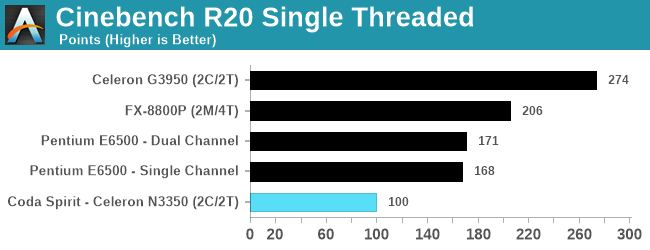
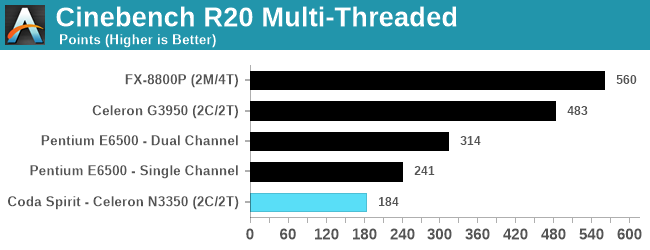
In single-threaded workloads, our 2016 chip is easily trounced by a 2009 Core CPU. Note however that the E6500 is a 65 W part and the N3350 is a 6 W CPU, so technically performance per Watt is on the side of the N3350.
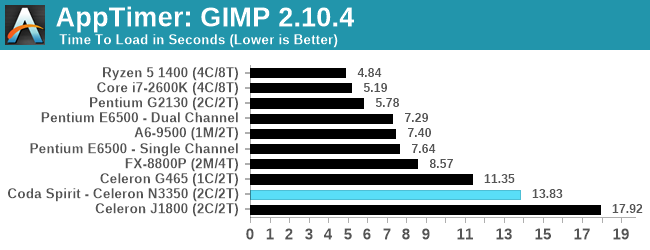
One key metric I like to see for these sorts of chips is application loading performance. At 13.8 seconds, this verifies what we saw in Cinebench R20: this chip is really slow in single threaded performance. Throughout all our testing, the biggest takeaway from it all was how long things took to load and to appear. Once it was in memory, it was perfectly fine, but that initial delay is going to slow everything down. For $100 it’s quite fast, but as a laptop on the go, I’d be tired of waiting. We loaded our application from the M.2 SATA drive, offering the fastest performance.
Gaming Performance
In our previous cheap system analysis, we used Counter Strike: Source with a timedemo benchmark. With such low-end graphics, even now with the 6W CPU that technically supports DirectX 12.1, gaming is going to be limited. Popular titles like Counter Strike, despite the longer loading times, are the sort of titles that are going to be the focus on gaming.
The E6500 we tested before used GMA4500 graphics, which are super old. This Celeron N3550 has HD 500 graphics, and is part of Intel’s Gen 9.5 family, so what we see here is a swing from a CPU limited test to a GPU limited test. Sort of. The N3350 is running in single-channel mode, which will hurt the performance quite a bit.

At all resolutions we have the N3350 beating the E6500 in single-channel, but it loses out at 800x600 to the dual channel E6500 results. It is worth noting that we saw 28 FPS for the E6500 DC at 1280x1024: for the Celeron N3350, we hit 1920x1080 to get the same 28 FPS result. So despite the large TDP difference between the two chips, and the CPU performance between the two, the Celeron’s newer graphics helps it in most gaming scenarios especially as we crank the resolution.
Display Metrics
On the cheaper devices, the display is usually one of the first things to go. To that end, I’ve seen 15-inch Ice Lake systems with 1366x768 displays! However one of the best upgrades for this Coda Spirit system is the 1920x1080 IPS display. Viewing angles and crispness is great. One of the areas I was concerned about though was brightness and color accuracy.
In our basic test, we saw 200 nits at 57% brightness, and a peak of 315 nits. This isn’t bad for a $100 laptop. The color accuracy saw all three colors remain surprisingly accurate through the test, with red being a little more prominent than the rest.
Speaker Performance
*This section has been updated since the review went live.
Users are either going to be relying on the speakers, the 3.5mm jack, or Bluetooth headphones . One area that has been made budget-class on this device is the speakers. I don’t have an objective test for this, but the best way to explain what I mean is to show you a video with the audio output. Video is taken with a Huawei P30 Pro smartphone.
When using the 3.5mm jack for headphones, none of the distortion was heard, and the audio was crisp. If someone uses this device, a 3.5mm headset or Bluetooth headphones are recommended for any sort of audio playback. The Type-C port should also support headphones.
Storage Performance
So one thing we can test here is the storage, especially given that we have official numbers on the Foresee eMMC onboard, as well as numbers from Coda on the M.2 SATA port. There are four different storage elements to this system:
- 32 GB onboard eMMC
- USB 3.0 Device (Mushkin Nano 128 GB MKNUFDIM128GB)
- microSD Card (Sandisk Ultra 256 GB A1-class)
- M.2 SATA Drive (Samsung Evo 860 250 GB)
CrystalDiskMark 7.0.0 x64 offers two types of benchmarks, one for ‘peak’ that gives an idealized scenario, and one for ‘real’ world scenarios. Here is the data for pure sequential transfers; other data is in the images below.
| Coda Spirit Storage Sequential Performance | ||
| AnandTech | Read | Write |
| Peak | ||
| Foresee eMMC 5.0 32 GB | 168.83 MB/s | 109.48 MB/s |
| Mushkin Nano 128 GB USB 3.0 | 157.06 MB/s | 23.28 MB/s |
| Sandisk Ultra 256 GB A1-Class microSDXC | 27.05 MB/s | 27.69 MB/s |
| Samsung EVO 860 250 GB M.2 SATA | 561,58 MB/s | 530.15 MB/s |
| Real | ||
| Foresee eMMC 5.0 32 GB | 157.90 MB/s | 107.58 MB/s |
| Mushkin Nano 128 GB USB 3.0 | 153.28 MB/s | 23.28 MB/s |
| Sandisk Ultra 256 GB A1-Class microSDXC | 26.85 MB/s | 27.05 MB/s |
| Samsung EVO 860 250 GB M.2 SATA | 451.55 MB/s | 432.79 MB/s |
As expected, the M.2 SATA drive is the better storage medium. Technically the eMMC falls into second place, though at 32 GB it is fairly limited. The USB and microSD are the backup options.
Nonetheless, having a $100 system with an optional M.2 SATA drive is a great add-on to have.
Battery Life and Charge Time
Another of the key areas that these cheap systems seem to lack is battery life – either though having a small battery or a high idle power draw, or both. If the OEM chooses a CPU that has a poor power profile, and then a display with a high power draw, it all compounds into a bad battery experience.
With the CODA Spirit, we have a 5000 mAh / 38 Wh battery, with a 1920x1080 screen and a 6W/4W processor. We put it through our regular movie playback test from our laptop reviews, with the display set to 200 nits.
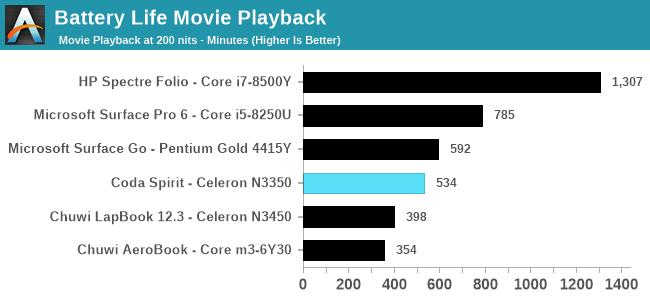
Almost 9 hours of battery for this sort of system is crazy good for $100.
The charge profile shows a constant charging rate until about 93%, then a slow trickle charge for the final bit of battery. In order to charge from 20% to 100% takes 161 minutes, or 2 hours 41 minutes. This is quite a long time to charge – there is no PD spec charging here, and the charging cord is akin to an old mobile phone charger.
Conclusion
Seeing a $100 notebook makes me very skeptical indeed. I’ve seen people be burned by paying a lot more than this for a lot less. The CODA Spirit, even without the price in mind, ticks some very nice boxes: a 13-inch 1920x1080 IPS display, a proper laptop keyboard and touchpad, an M.2 SATA slot to add your own drive into, and almost 9 hours of movie playback. Even with just those specifications, $100 seems like a crazy price.
Of course, there are downsides. The CPU performance is poor, meaning that even with SATA storage the application loading time is long and easily something to get frustrated over. The speakers are best left unsaid, which kind of makes that movie playback number is when using headphones or BT speakers, the latter of which will affect battery life. The single-channel DRAM is probably hurting the gaming, and the 4 GB + 32 GB really needs to be 8 GB + 128 GB to be considered for a proper on-the-road working system.
The CODA Spirit likely fulfills the need for a college student who is only ever going to use it to take notes. The battery should last a full day of lectures (or almost a full day) or in the library, but starting to open multiple tabs might start to stretch the system. Add in an M.2 drive (or a microSD card) to take away any capacity anxiety, and make sure everything is backed up in the cloud too.
My lasting impression of the device is the fact that I had all my technical questions answered was superb. This combination of hardware was not something I was expecting for the price, and it sets the benchmark for any of the major OEMs. I was very pleasantly surprised by the CODA Spirit. For the price, it’s great.


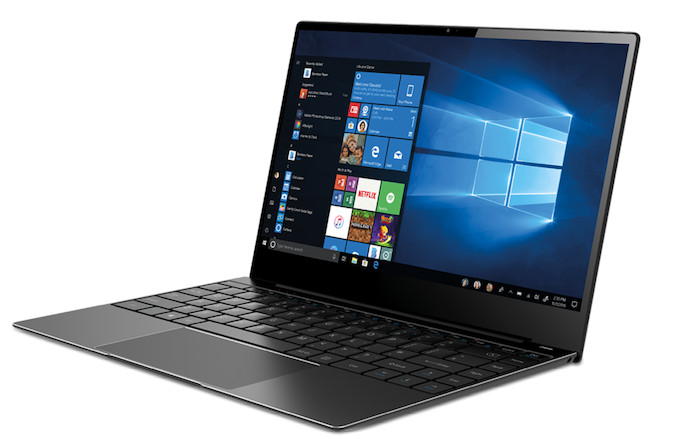
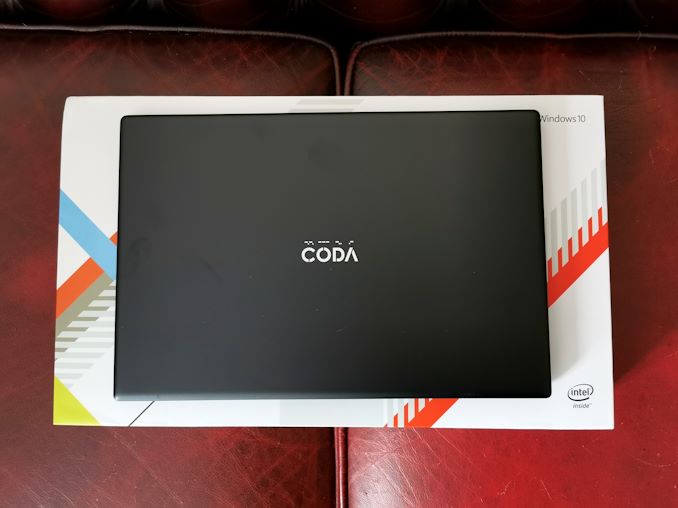
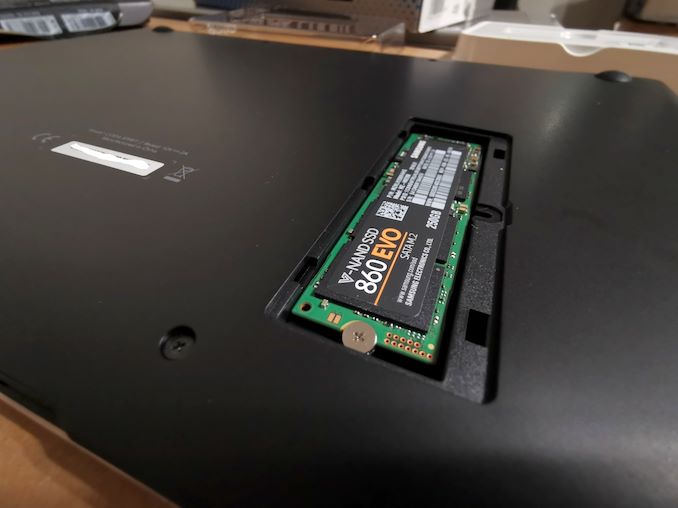
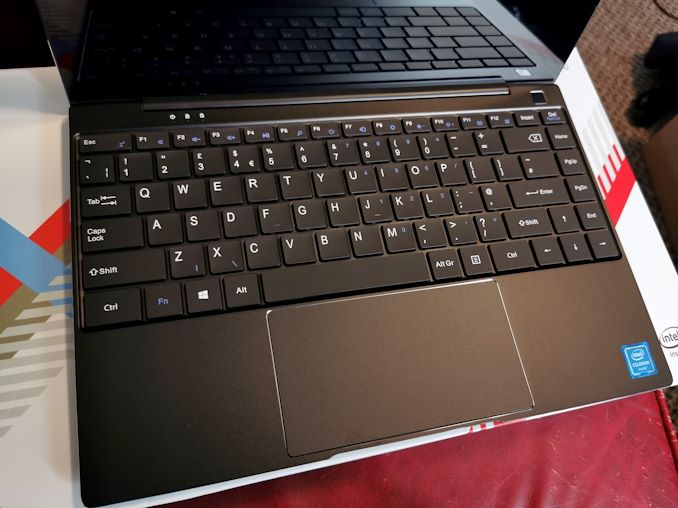


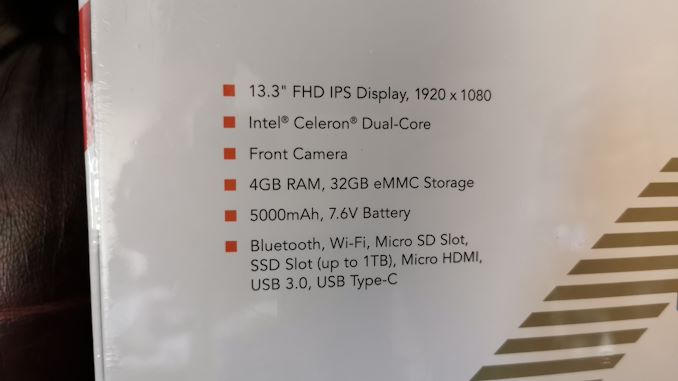
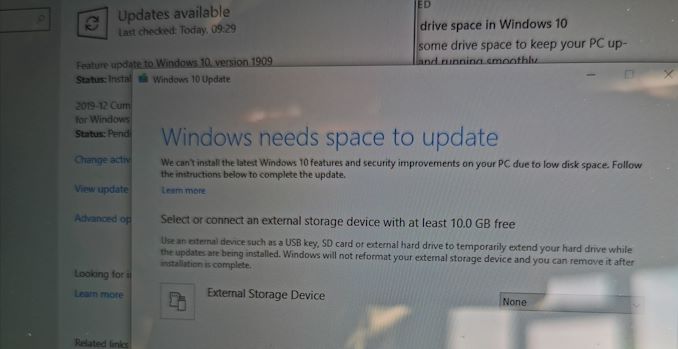

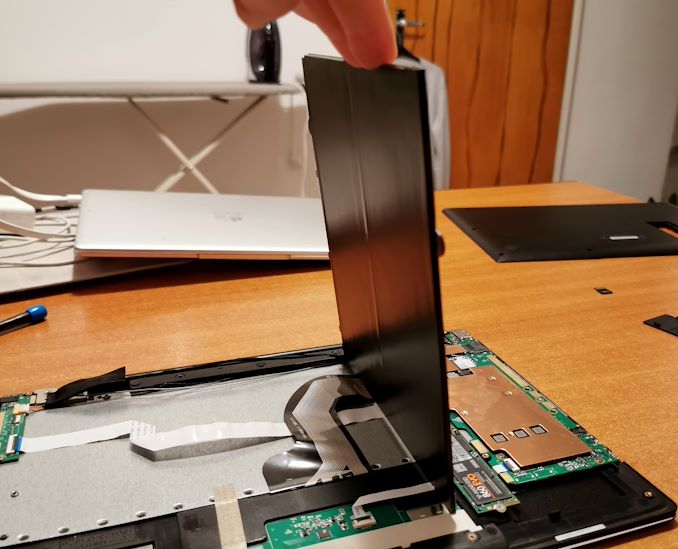
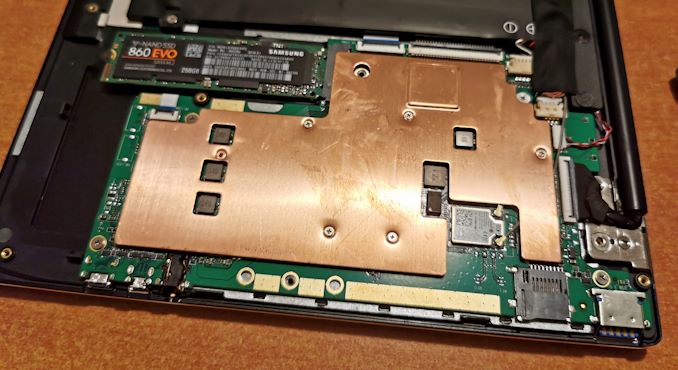
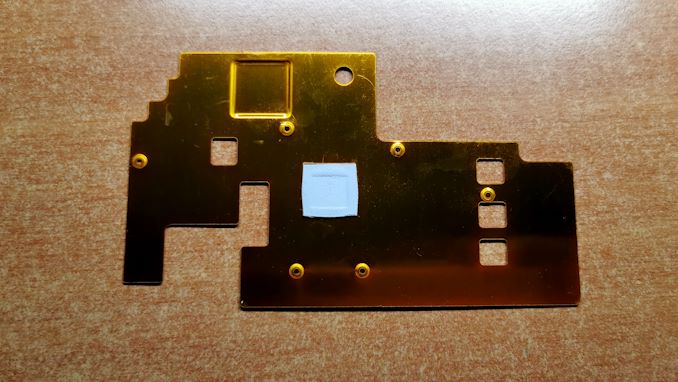

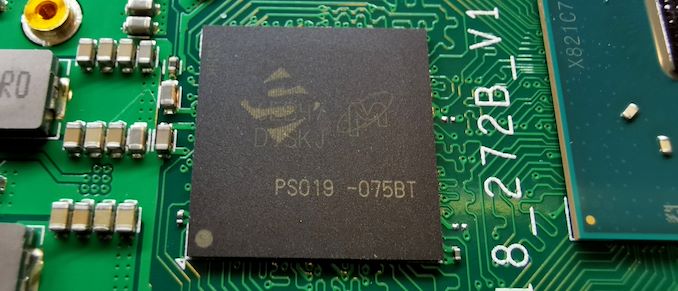

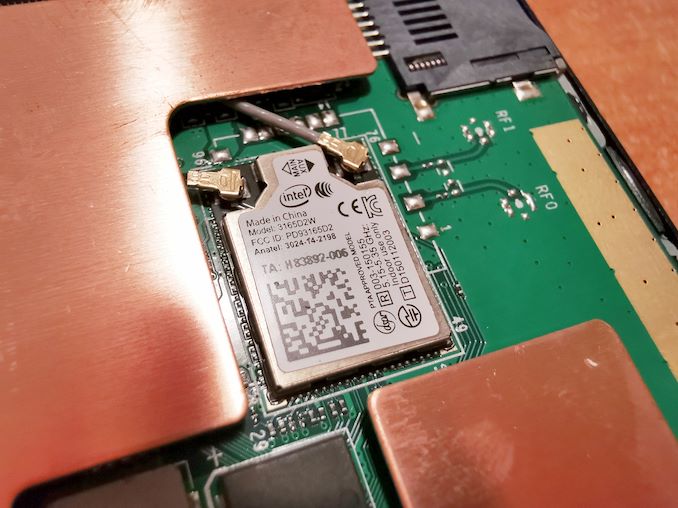

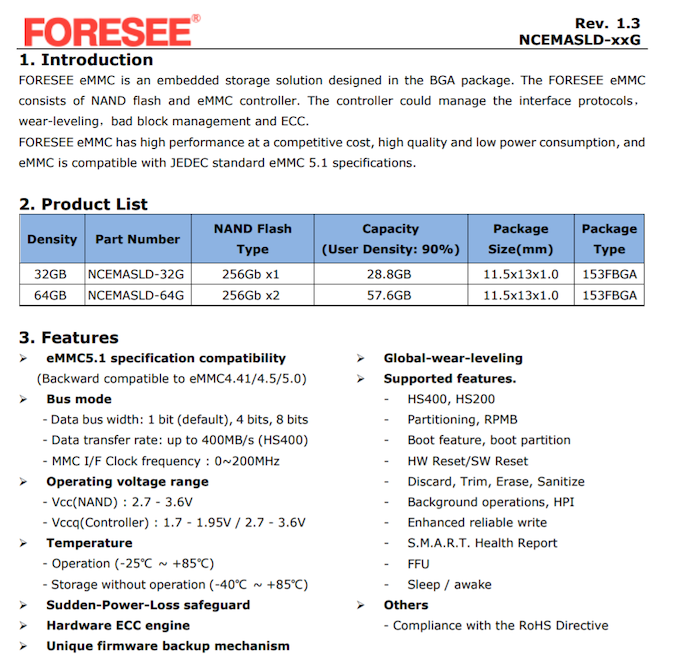

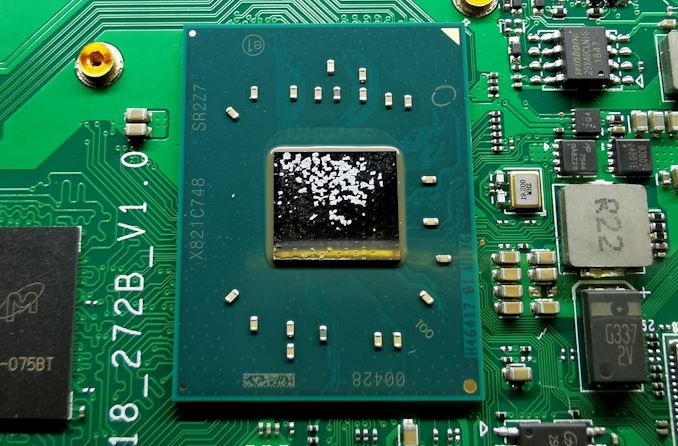






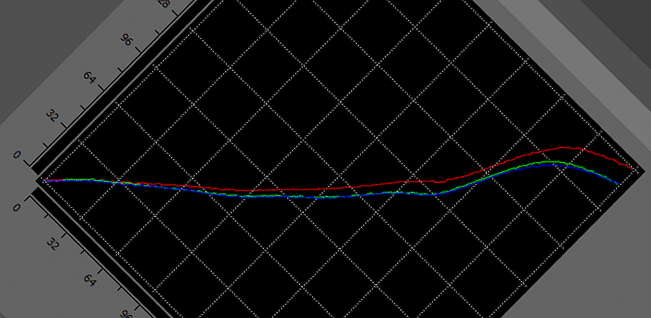
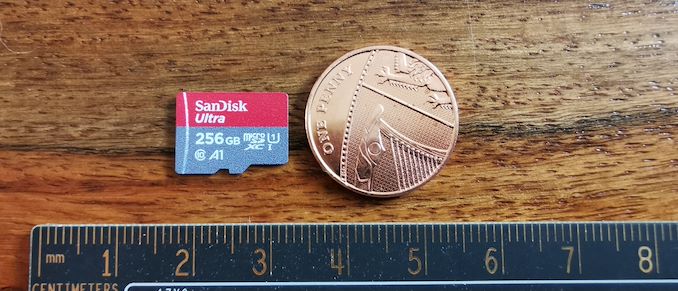






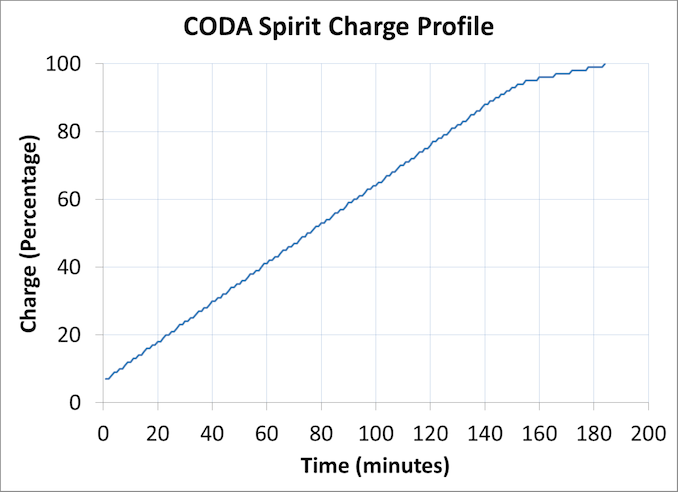
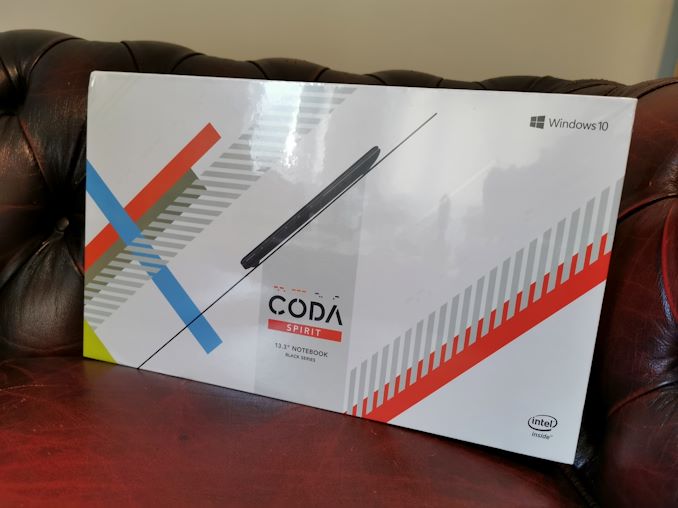








99 Comments
View All Comments
HStewart - Monday, March 9, 2020 - link
One thing that I don't understand why did qualcomm aim at this market - it would be more successful.Retycint - Monday, March 9, 2020 - link
Its chips are far too expensive, I suspect. The lower end chips are probably not good enough to even run WindowsHStewart - Monday, March 9, 2020 - link
Yes... maybe a Chrome laptop would be better suited for the processor - not windows.Microsoft has created there own variant - they probably hoping they can become like Apple and lock people in to there own technology.
lotbass - Monday, March 9, 2020 - link
Where do we order from the US?Midwayman - Monday, March 9, 2020 - link
I'm struggling to see where I'd want something like this over a low end ipad. For really basic computing needs they are fine and really snappy. I've seen them on sales around $200 from time to time, which by the time you add storage to this, you are getting close. Its just really hard to recommend ultra low end hardware. I guess it might make an okay dumb terminal for things you just need an interface. Like my 3d printer, etc.Retycint - Monday, March 9, 2020 - link
Windows vs iOS, physical keyboard, 13" screen etc, and also $130-200 cheaperCalista - Tuesday, March 10, 2020 - link
I have the Acer Swift One with very similar specifications, be it with a 128 GB SSD instead of the 32 GB eMMC on the Coda. And compared to my Latitude E7450 (i5-5200u with 8 GB of RAM) the Acer perform rather well. Yes, it's sluggish when trying to do many things at once, and the CPU tend to hit 100 percent all the time. But for its intended use, i.e. reading documents, browsing the internet and playing video and music it actually works surprisingly well.Death666Angel - Tuesday, March 10, 2020 - link
You might not want it, but others might for the reasons Retycint showed. An Apple tablet for around 300USD and up is something different than a Windows Laptop for around 200USD and down or thereabouts.t.s - Monday, March 9, 2020 - link
It will be very intersting if anandtech can compare this CPU or the rest of those CPU (celeron 3995 etc) with ARM, like RK3399.HStewart - Monday, March 9, 2020 - link
I have often thought of this - they are two different architectures - CISC vs RISC, now for generic bench marks, Risc has advantages but more complex stuff CISC has it.But I also believe that 64 bit has made developers lazy, it simpler to add more memory than to fight down memory leaks.
What would be really interesting to see one of these laptops on Windows XP's likely more powerful than the CPU's in those days.